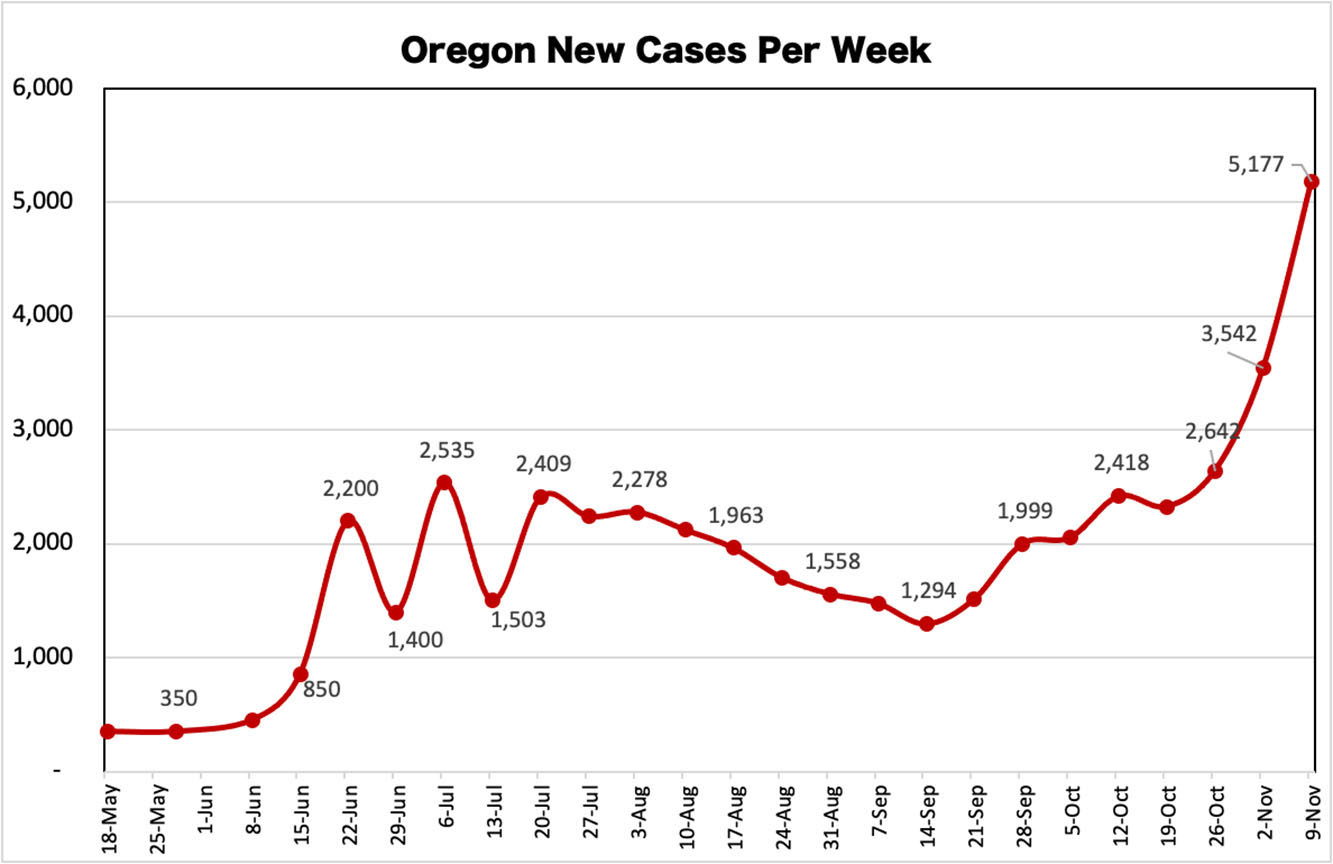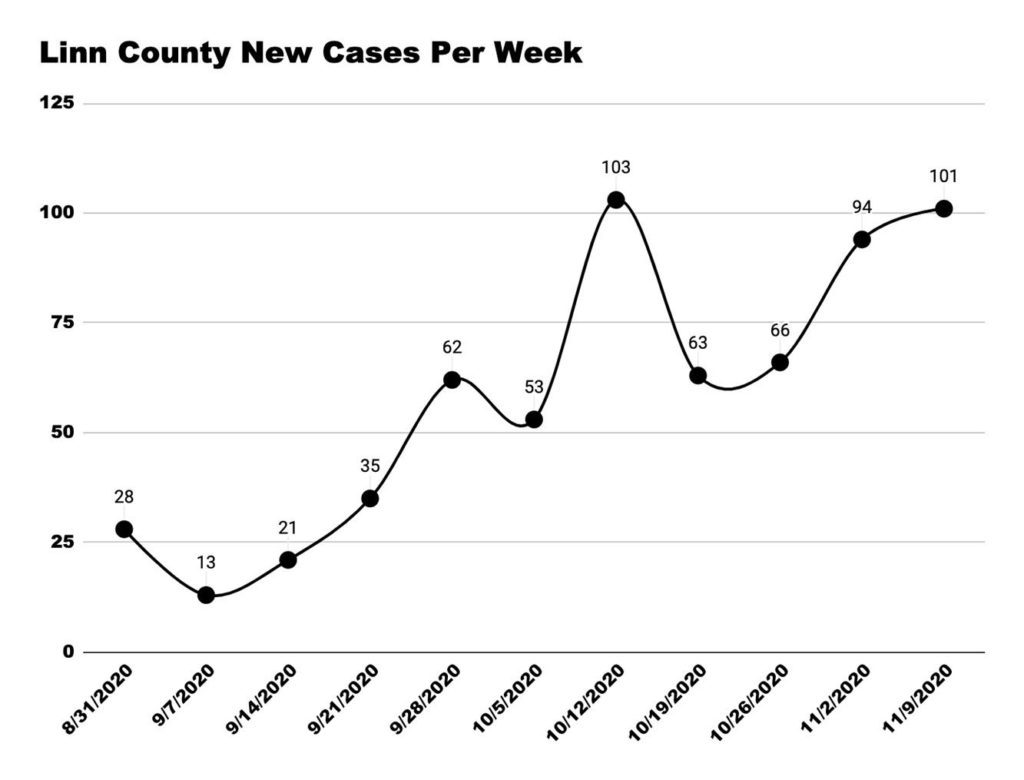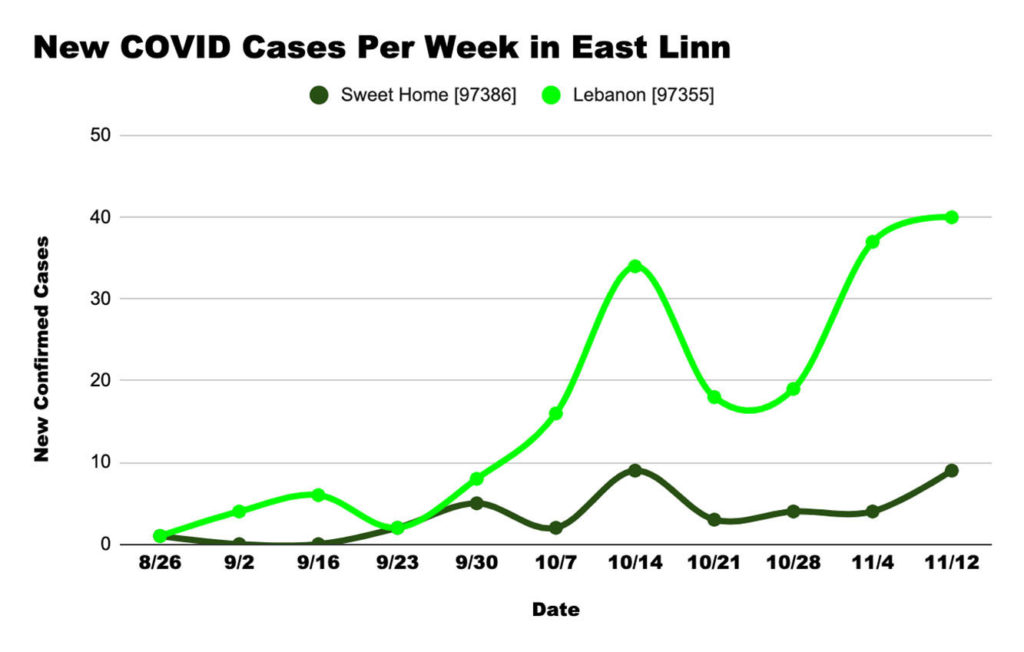By Kelly Kenoyer
Lebanon Local
*Note: Gov. Kate Brown issued an updated press release Nov. 13, right after this story went to press.
After record-shattering spikes in COVID-19 cases across Oregon, Gov. Kate Brown held a press conference on Friday, Nov. 6, to announce new restrictions for the worst-off counties and to beg the rest of Oregon to be more careful to stop the spread.
“I’m announcing a two-week pause on social activities for counties with more than 200 cases per 100,000 over a two-week period,” Brown said, adding similar restrictions for smaller counties. The move impacted five counties immediately, but five more were on the cusp when she spoke Friday, including Linn County.
“We will be pulling data for the full state on Monday, but particularly for these five counties. Should they meet these metrics, they will also start a two-week pause,” she said.
At press time on Thursday, Nov. 12, Linn County had had 191 new cases of COVID in the previous 14 days: A case rate of 147.2 per 100,000.
Lebanon’s ZIP code saw a record-breaking 40 new cases in the week ending Nov. 12, which is a total case count of 269 cases since the beginning of the pandemic. Lebanon’s spike that week was mirrored by record-breaking cases across Oregon: Nov. 12 was the first day Oregon broke 1,000 new cases in a day, at 1,122. The previous record was 988 on Nov. 7.
Because Linn remains below the 200 per capita mark, the restrictions haven’t been implemented here yet, though the other nine counties are now on that pause. They involve additional restrictions on businesses: restaurants in the impacted counties will need to reduce their indoor seating, and indoor recreational activities are limited to 50 people, including in gyms.
Additionally, the governor is asking businesses in the paused counties to have their workers work from home as much as possible, and in-person visits to long-term care facilities are on hold.
Finally, “Indoor social get-togethers will be limited to single households only or a maximum of six people during the pause,” Brown said. “We’ve been asking Oregonians over the past several weeks to be mindful of social gatherings, as they continue to be the main driver of social spread.”
Enforcement of these measures is limited to state agencies like OSHA and OLCC going after non-compliant businesses, Brown added.
“The consequences are the community impacts, honestly” she said, visibly frustrated. “That our cases are likely to continue to increase, that we’re likely to see more deaths, unfortunately, and we’re beginning to stretch our hospital capacity and staff here in the metro area.”
In a single week at the end of October, Oregon saw a 34% increase in COVID-19 cases and a jump in the case positivity rate as well. Oregon saw 160 hospitalizations that week, and has had 716 total COVID-19 deaths.
Nationwide, more than 243,000 people have died of COVID-19, which is now the third leading cause of death in the country. Public Health Officials in Oregon have repeatedly said Oregon is doing better than most other states, and the data bears that out: the CDC has Oregon as the state with the fourth fewest cases per capita in the entire country throughout the course of the pandemic.
Still, experts say the rise in cases in Oregon is alarming.
“People are not doing this intentionally,” State Epidemiologist Dean Sidelinger said of the spiking COVID cases. “People are not going out when they have symptoms or know they’ve tested positive. These are people who have no symptoms yet or won’t develop them at all.”
Sidelinger suggested that all Oregonians should try to limit their total social gatherings to three or less in a two-week period as a benchmark, including those outside the paused counties.
He also had advice ahead of the Thanksgiving holiday, notably that Oregonians should avoid holiday gatherings that don’t comply with the new recommendations.
“Limit your exposure to non-household members for 14 days before visiting older relatives who are at higher risk for infection. This self-quarantine period can reduce but not eliminate risk, and that’s why we’re asking you to cancel these gatherings. But if you decide to go forward with them, that 2-week pause can help to keep your loved ones safe.”
Sidelinger again emphasized the severity of the disease, noting that the death rate for coronavirus is 20 times higher than the death rate for the flu.
“We don’t want to bring COVID-19 home for the holidays and get a loved one sick,” he said.
But Public Health Director Rachael Banks said many Oregonians and businesses have worked hard to fight the spread. “Twice now, Oregonians have stopped a surge of COVID-19 cases,” she said, pointing to peaks in spring and summer which were stalled and reversed.
She said Oregonians can work together to push COVID back again.
“Since the start of the pandemic, Oregon has one of the lowest cases in the nation, and has remained a bright spot in the nation’s troubled COVID-19 response,” she said, but “as the weather worsens, as the days get shorter, as more people stay indoors and as we observe holiday seasons, we are all at greater risk.”






